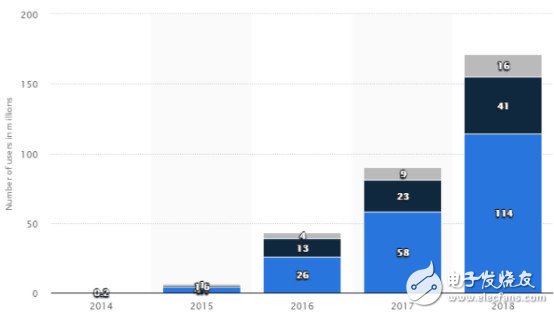Recently, a well-known foreign technology media, The Next Web, released its forecast on the five major trends shaping virtual reality (VR) in 2018. This prediction highlights the rapid evolution and increasing mainstream adoption of VR technology across various industries. One of the key predictions is that VR will become more widely accepted and integrated into everyday life. Looking at the growth of the industry over the past few years, it's clear that VR has reached a significant turning point. In 2014, there were only about 200,000 active VR users. By 2017, this number had surged to 90 million, and by 2018, it was expected to reach nearly 170 million—almost doubling from the previous year. These numbers show just how fast the market is expanding. The chart below, sourced from Statista, illustrates the exponential growth in VR user base and market size: As shown in the data, the VR software industry alone grew from $129 million in 2015 to an impressive $2.57 billion in 2018. And by 2025, the entire VR industry is expected to be worth as much as $45 billion, compared to just $90 million in 2014. This dramatic growth indicates that VR is no longer a niche technology—it's becoming a powerful force in the digital world. With such rapid development, the question arises: what are the key trends driving this transformation? Here are five major developments predicted for 2018: 1. More 360-Degree VR Videos Emerge According to a report by Omnivirt, 360-degree videos have seen higher engagement than traditional content. Their research, based on over 1,000 events, showed increased video completion rates, clicks, and overall participation. Moreover, the quality and variety of 360-degree content are improving every year. Major companies like NASA, Microsoft, IBM, Honda, and Ford are already using these immersive formats. YouTube’s 360-degree channel now has nearly 3 million subscribers, signaling a shift toward more interactive and engaging experiences. We can expect even more widespread use of 360-degree VR videos in the future. 2. Increased Use of Augmented Reality (AR) in Advertising AR is quickly becoming a powerful tool in the advertising industry. Last year, Google launched VR-based ads, while Infiniti partnered with Omnivirt to offer 360-degree car test drives. Chick-fil-A also introduced VR websites and interactive content. These examples show how AR and VR are being used to create unique and memorable brand experiences. As more companies adopt these technologies, we can expect a surge in AR-driven marketing campaigns in 2018, further accelerating VR adoption. 3. A Surge in VR Developers As VR continues to grow, the demand for skilled developers is rising. While VR game development has been ongoing, the need for more creators and engineers is expected to increase significantly. Tech giants like Google are investing in supporting VR content creators financially, aiming to foster a thriving ecosystem. This trend shows that talent development is crucial for the long-term success of the VR industry. 4. More Immersive Experiences One of the most exciting aspects of VR is its ability to provide highly realistic and immersive experiences. Recent innovations, such as HEAR360’s full-face stereo microphone, allow for 360-degree audio that enhances the sense of presence. This kind of advancement brings users closer to real-world sensations, making VR feel more authentic. Some experts even predict that future VR devices may simulate smell and touch, creating an even deeper level of immersion. 5. Lower Costs and Improved Usability In 2017, companies like Oculus and HTC started a price war, reducing the cost of VR headsets by $200. This trend is expected to continue in 2018, making VR more accessible to the general public. Currently, most VR hardware is expensive, limiting its appeal to casual users. However, as prices drop and usability improves, VR is likely to become a household staple, just like smartphones or gaming consoles. In conclusion, 2018 is set to be a pivotal year for virtual reality. With growing adoption, more immersive content, better tools for developers, and falling costs, VR is moving from a novelty to a mainstream technology. As the industry continues to evolve, we can expect even more groundbreaking innovations in the coming years. Switching Power,Embedded Switching Power,Intelligent Battery Management,Power Supply System Guangdong Yuqiu Intelligent Technology Co.,Ltd , https://www.cntcetltd.com